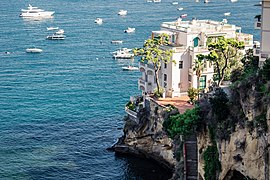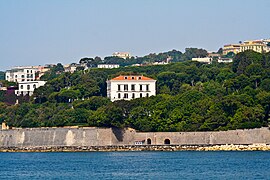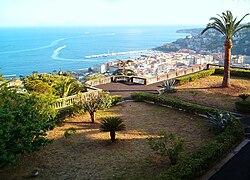
A Roman villa was typically a farmhouse or country house built in the Roman Republic and the Roman Empire, sometimes reaching extravagant proportions.

Pompei or Pompeii, is a city and commune in the Metropolitan City of Naples, Italy, home of the ancient Roman ruins of Pompeii that are part of the UNESCO World Heritage Sites.

Cosimo Fanzago was an Italian architect and sculptor, generally considered the greatest such artist of the Baroque period in Naples, Italy.
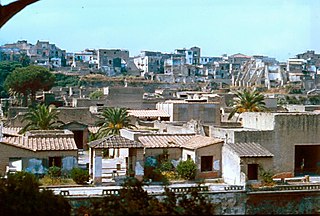
Ercolano is a town and comune in the Metropolitan City of Naples, Campania of Southern Italy. It lies at the western foot of Mount Vesuvius, on the Bay of Naples, just southeast of the city of Naples. The medieval town of Resina was built on the volcanic material left by the eruption of Vesuvius that destroyed the ancient city of Herculaneum, from which the present name is derived. Ercolano is a resort and the starting point for excursions to the excavations of Herculaneum and for the ascent of Vesuvius by bus. The town also manufactures leather goods, buttons, glass, and the wine known as Lacryma Christi.

Posillipo is an affluent residential quarter of Naples, southern Italy, located along the northern coast of the Gulf of Naples.

The Villa Poppaea is an ancient luxurious Roman seaside villa located in Torre Annunziata between Naples and Sorrento, in Southern Italy. It is also called the Villa Oplontis or Oplontis Villa A. as it was situated in the ancient Roman town of Oplontis.

Boscoreale is an Italian comune and town in the Metropolitan City of Naples, Campania, with a population of 27,457 in 2011. Located in the Vesuvius National Park, under the slopes of Mount Vesuvius, it is known for the fruit and vineyards of Lacryma Christi del Vesuvio. There is also a fine Vesuvian lava stone production.
Boscotrecase is a comune (municipality) in the Metropolitan City of Naples in the Italian region Campania, located about 20 km southeast of Naples.

Palazzo Donn'Anna is a historic residence in Naples, Italy. It sits prominently at water's edge at the beginning of the Posillipo coast, just west of the Mergellina boat harbor. The building is on the site of the so-called "Rocks of the Siren" and, indeed, was originally called La Villa Sirena.

Villa Boscoreale is a name given to any of several Roman villas discovered in the district of Boscoreale, Italy. They were all buried and preserved by the eruption of Mount Vesuvius in 79 AD, along with Pompeii and Herculaneum. The only one visible in situ today is the Villa Regina, the others being reburied soon after their discovery. Although these villas can be classified as "rustic" rather than of otium due to their agricultural sections and sometimes lack of the most luxurious amenities, they were often embellished with extremely luxurious decorations such as frescoes, testifying to the wealth of the owners. Among the most important finds are the exquisite frescoes from the Villa of Publius Fannius Synistor and the sumptuous silver collection of the Villa della Pisanella, which are now displayed in several major museums.
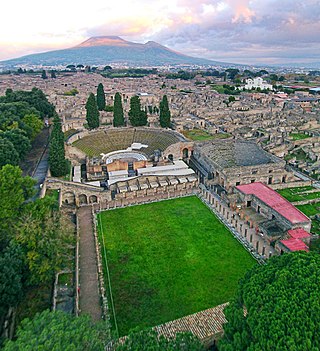
Pompeii was an ancient city located in what is now the comune of Pompei near Naples in the Campania region of Italy. Pompeii, along with Herculaneum and many villas in the surrounding area, was buried under 4 to 6 m of volcanic ash and pumice in the Eruption of Mount Vesuvius in 79 AD.

Stabiae was an ancient city situated near the modern town of Castellammare di Stabia and approximately 4.5 km southwest of Pompeii. Like Pompeii, and being only 16 km (9.9 mi) from Mount Vesuvius, this seaside resort was largely buried by tephra ash in 79 AD eruption of Mount Vesuvius, in this case at a smaller depth of up to five metres.

The following is a timeline of the history of the city of Naples. The Naples area has been inhabited since the Neolithic period. The earliest historical sources in the area were left by the Myceneans in the 2nd millennium BC. During its long history, Naples has been captured, destroyed and attacked many times. The city has seen earthquakes, volcanic eruptions, foreign invasions and revolutions.

The Palazzo Zevallos Stigliano is a Baroque palace located on Via Toledo number 185 in the quartiere San Ferdinando of central Naples, Italy. It is also called the Palazzo Zevallos or Palazzo Colonna di Stigliano, and since 2014 serves as a museum of artworks, mainly spanning the 17th through the early 20th centuries, sponsored by the Cultural Project of the bank Intesa Sanpaolo. This museum is linked to the Museum or Gallerie di Piazza Scala in Milan and the Museum at Palazzo Leoni Montanari in Vicenza, also owned by the Bank.

The Pompeii Lakshmi is an ivory statuette that was discovered in the ruins of Pompeii, a Roman city destroyed in the eruption of Mount Vesuvius 79 CE. It was found by Amedeo Maiuri, an Italian scholar, in 1938. The statuette has been dated to the first-century CE. The statuette is thought of as representing an Indian goddess of feminine beauty and fertility. It is possible that the sculpture originally formed the handle of a mirror. The yakshi is evidence of commercial trade between India and Rome in the first century CE.

The Villa Carafa of Belvedere, formerly known as Palazzo Vandeneynden, and also known as Villa Belvedere, is a monumental villa in Naples, located in the hilly Vomero district. The villa was commissioned by the powerful magnate, nobleman and art collector Ferdinando Vandeneynden, also known as Ferdinand van den Eynde, from the Carthusian architect Bonaventura Presti.
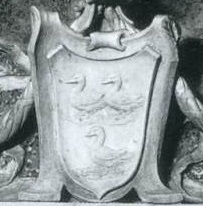
Ferdinand van den Eynde, 1st Marquess of Castelnuovo was an Italian nobleman and magnate of Flemish descent. He was the son of Jan van den Eynde, and the father of Elisabeth van den Eynde, Princess of Belvedere and Baroness of Gallicchio and Missanello and Jane (Giovanna) van den Eynde, Princess of Galatro and Sonnino. He should not be confused with his namesake and uncle Ferdinand van den Eynde.

Elisabeth van den Eynde, Princess of Belvedere and suo jure Baroness of Gallicchio and Missanello was an Italian noblewoman. She was the consort of Carlo Carafa, 3rd Prince of Belvedere, 6th Marquess of Anzi, and Lord of Trivigno, and the daughter of Ferdinand van den Eynde, 1st Marquess of Castelnuovo and Olimpia Piccolomini, of the House of Piccolomini. Her grandfather was Jan van den Eynde, a wealthy Flemish merchant, banker and art collector who purchased and renovated the Palazzo Zevallos Stigliano in 1653. Her father Ferdinand, the Marquess of Castelnuovo, built the Vandeneynden Palace of Belvedere between 1671 and 1673. While the Palazzo Zevallos in central Naples passed to her elder sister Giovanna, who married a Colonna heir, Elisabeth was given the monumental Palazzo Vandeneynden, alongside a smaller portion of the Marquess' assets, which included his art collection, one of the largest and most valuable in Naples and its surroundings. Upon her marriage to Carlo Carafa, the Vandeneynden Palace came to be known as Villa Carafa.
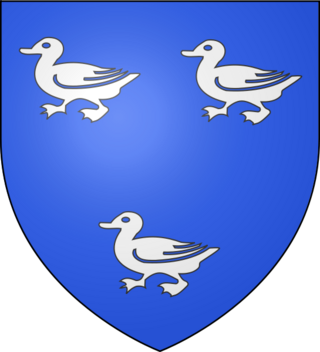
Van den Eynde is the name of an old Netherlandish noble family. One of the earliest recorded Van den Eynde to use the three-duck canting arms was Jacob van den Eynde, first Councilor and pensionary of Delft, and the highest official in the county of Holland. The Van den Eynde became especially prominent in 16th-century Delft, 17th-century Antwerp and Naples.

Geremia Discanno, 1839 - 1907, was an Italian genre and landscape painter, who collaborated with archaeologist Giuseppe Fiorelli, art historian Emil Presuhn, and Naples-based chromolithographer Victor Steeger, to record wall paintings in the Roman ruins of Pompeii and Herculaneum that were being excavated at the time.


